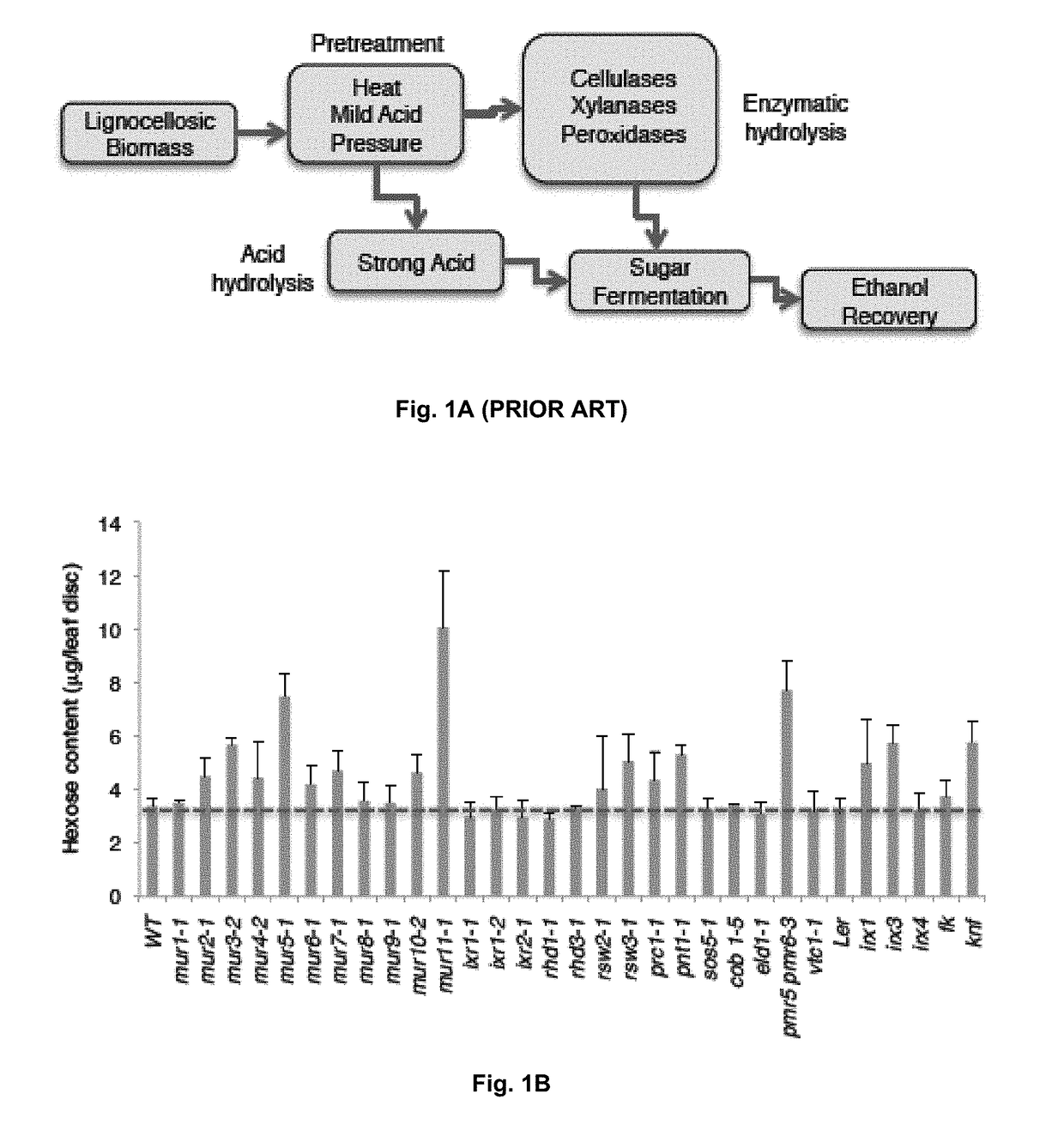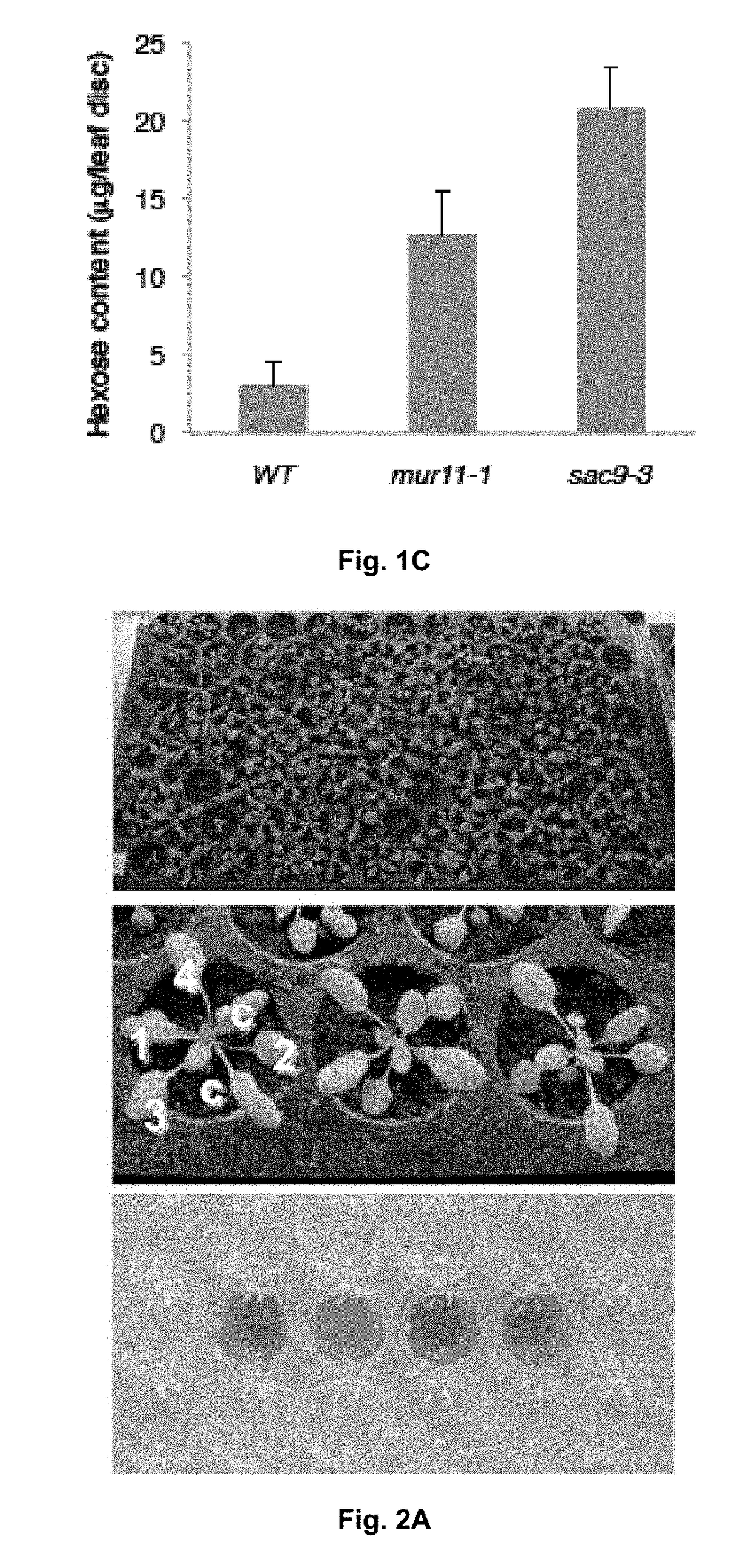Compositions, methods, and plant genes for the improved production of fermentable sugars for biofuel production
- Summary
- Abstract
- Description
- Claims
- Application Information
AI Technical Summary
Benefits of technology
Problems solved by technology
Method used
Image
Examples
example 1
for Wall Hydrolysis Sensitive Mutants
[0105]A colorimetric assay was developed that allowed for the visualization of saccharification from plant tissue incubated in dilute acid at room temperature for one hour.
[0106]Using an anthrone reagent, which turns blue or green in the presence of sugars, (in this example, hexoses,) an average sugar release (4.1±0.1 μg sugar / leaf disc) from 100 wild type leaf samples was determined (FIG. 5). With this baseline, the assay was applied against a collection of 30 known cell wall mutants as indexed by the Plant Cell Wall Biosynthesis Research Network (WallBioNet) (FIG. 1(b)).
[0107]Table 1 shows known cell wall mutants and their gene products. MUR11 was molecularly identified in this study and is shown in the table in bold.
TABLE 1MutantAGIGENEcsld3-1At3g03050CELLULOSE SYNTHASE-LIKE 3eld1-1At3g08550ELONGATION DEFECTIVE 1fkAt3g52940FACKELirx1At4g18780IRREGULAR XYLEM 1 / CESA8irx3At5g17420IRREGULAR XYLEM 3 / CESA7 / MUR10irx4At1g15950IRREGULAR XYLEM 4 / CINNAMO...
example 2
Genes Involved in Starch Metabolism Improve Saccharification
[0114]To understand the molecular nature of the mutant category that showed both a high saccharification and increased starch accumulation, map-based cloning of the mutant alleles was performed on three lines (whs1, whs22 and whs9). The whs1 and whs22 lines contained allelic mutations in the DISPROPORTIONATING ENZYME 2 (DPE2) gene, which encodes a glucosyltransferase required for starch degradation, and these lines were subsequently re-designated dpe2-100 and dpe2-101 respectively (FIG. 6, Table 2). Subsequent molecular analysis of lines whs3, whs5, whs14, whs21 showed they were siblings of whs1. The whs9 line contained a new allele of STARCH EXCESS 4 (sex4-100), which encodes a glycan phosphatase involved in starch degradation (FIG. 6, Table 2).
[0115]The identification of these genes was validated by showing that T-DNA knockout insertion alleles in both DPE2 and SEX4 also showed improved sugar release by acid hydrolysis (F...
example 3
g Polar Auxin Transport Improves Saccharification
[0118]Among those lines which showed good sugar release in both fresh and senesced tissue, one line (whs20) in particular stood out because it showed an incompletely penetrant pin-shaped inflorescence phenotype that was reminiscent of mutations that perturb the polar transport of the plant hormone auxin. Subsequent molecular analysis of this line identified a mutation in the PINOID (PID) gene (FIG. 6; Table 2). PID encodes a serine threonine protein kinase that is thought to play a role in the cellular localization of the PIN efflux auxin carrier. Mutations in other genes that result in a pin-shaped phenotype, such as pin1 and mp (also known as arf5), also show an improved saccharification phenotype (FIG. 4(a)). By contrast, other auxin response factor mutants defective in auxin signalling (arf6, 7, 8 and 19), did not show increase sugar release, however, these mutants also do not have the pin inflorescence phenotype. Furthermore, non...
PUM
| Property | Measurement | Unit |
|---|---|---|
| Fraction | aaaaa | aaaaa |
| Fraction | aaaaa | aaaaa |
| Fraction | aaaaa | aaaaa |
Abstract
Description
Claims
Application Information
 Login to View More
Login to View More - R&D Engineer
- R&D Manager
- IP Professional
- Industry Leading Data Capabilities
- Powerful AI technology
- Patent DNA Extraction
Browse by: Latest US Patents, China's latest patents, Technical Efficacy Thesaurus, Application Domain, Technology Topic, Popular Technical Reports.
© 2024 PatSnap. All rights reserved.Legal|Privacy policy|Modern Slavery Act Transparency Statement|Sitemap|About US| Contact US: help@patsnap.com










